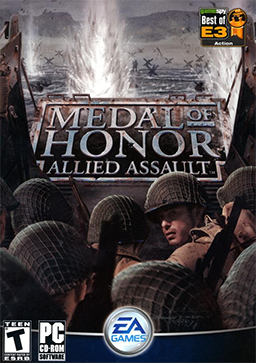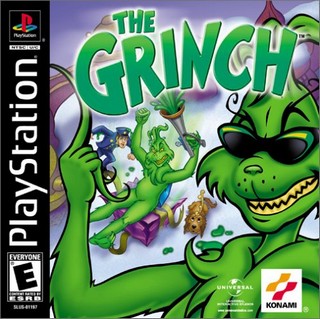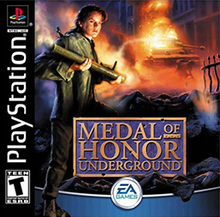
Medal of Honor: Allied Assault is a 2002 first-person shooter video game developed by 2015, Inc. and published by Electronic Arts. It was released for Windows, Mac OS X, and Linux. Allied Assault is the third game in the Medal of Honor series. The game uses the id Tech 3 engine, with modifications from Heavy Metal: F.A.K.K.², to simulate infantry combat in the European and North African theaters during World War II.

Medal of Honor is a series of first-person shooter video games created by American film director and producer Steven Spielberg. The first game was developed by DreamWorks Interactive and published by Electronic Arts for the PlayStation in 1999. Medal of Honor spawned a series of follow-up games including multiple expansions spanning various console platforms and personal computers.

Medal of Honor: Frontline is a first-person shooter video game, in the Medal of Honor series, and was published by Electronic Arts. The player character is Lt. Jimmy Patterson, from the American Office of Strategic Services. Frontline takes place during the events of the first game and chronicles Patterson's journey as he fights his way across Europe into Nazi Germany during World War II. Frontline was released in North America for the PlayStation 2 on May 29, 2002 and for the GameCube and Xbox consoles on November 7, 2002.

Michael Giacchino is an American composer of music for film, television, and video games. He has received many accolades for his work, including an Oscar for Up (2009), an Emmy for Lost (2004), and three Grammy Awards.

NBA Live 2000 is the 2000 installment of the NBA Live video game series. The cover features Tim Duncan of the San Antonio Spurs. The game was developed by EA Sports and released in 1999. Don Poier is the play-by-play announcer with Reggie Theus on color commentary. The game features Michael Jordan in his first official appearance in the series. The PC version of the game introduced EA's "Face in the Game" feature, allowing players to use custom facial photographs on created players. It was also the final NBA Live game released for Nintendo 64. NBA Live 2000 is followed by NBA Live 2001. A cancelled Game Boy Color version was in development by Handheld Games for THQ, but it was scrapped during testing.

FIFA 2000 is a football simulation video game developed by EA Canada and published by Electronic Arts. It was the seventh game in the main FIFA series. The game was released for Microsoft Windows and PlayStation. A version for the Game Boy Color was developed by Tiertex Design Studios and published by THQ.

Madden NFL 2001 is an American football video game. It is the third in the Madden NFL series to include an NFL player, Tennessee Titans running back Eddie George, on its cover. In addition, it is the first game in the series to have a player, instead of John Madden featured prominently on the box art. Madden's picture is shown on a small logo, which would reappear for every following game until Madden NFL 06. It is also the first game in the Madden NFL series to appear on the PlayStation 2 game console. This is the first Madden game to feature NFL Europe teams.

Hogs of War is a 2000 turn-based tactics video game developed by Infogrames Sheffield House and published by Infogrames for the PlayStation and Microsoft Windows. The game is set in the First World War-era where anthropomorphic pigs engage in combat. Hogs of War features 3D graphics and both a single-player career mode and offline multiplayer, with voice artistry by British comedic actors Rik Mayall and Marc Silk.

Need for Speed: Porsche Unleashed, released as Need for Speed: Porsche 2000 in Europe and Need for Speed: Porsche in Latin America and Germany, is a 2000 racing video game. It is the fifth installment in the Need for Speed series. Unlike other NFS titles, Porsche Unleashed centers on racing Porsche sports cars, with models ranging from years 1950 to 2000.

Tomb Raider: Chronicles is an action-adventure video game developed by Core Design and published by Eidos Interactive. It was first released for PlayStation, Windows, and Dreamcast in 2000, then on Mac OS the following year. It is the fifth installment in the Tomb Raider series. The narrative continues from Tomb Raider: The Last Revelation with archaeologist-adventurer Lara Croft presumed dead, and three friends recall adventures from her early career. Gameplay follows Lara through linear levels, solving puzzles and fighting enemies. Some levels incorporate additional gameplay elements such as stealth.

Ms. Pac-Man Maze Madness is a maze chase video game developed and published by Namco for the PlayStation in 2000. It was later released for the Nintendo 64, Dreamcast, and Game Boy Advance. A remake of Ms. Pac-Man (1982), players control the titular character in her quest to stop a witch named Mesmerelda from stealing the Gems of Virtue. The game was well-received upon release, with critics applauding its simplicity and faithfulness to the arcade original. A sequel was in development around 2006, but was cancelled for unknown reasons.

WWF Attitude is a professional wrestling video game based on the World Wrestling Federation released by Acclaim Entertainment in 1999 for the PlayStation and Nintendo 64. A slightly enhanced port of the game was later released for the Dreamcast, as well as a handheld version for the Game Boy Color. The game is named after the WWF's then-current "Attitude" marketing campaign, with the tagline "Get it" also being used on company programming during that period.

Medal of Honor is a 1999 first-person shooter video game, developed by DreamWorks Interactive and published by Electronic Arts for PlayStation. It is the first installment in the Medal of Honor video game series. The gameplay features the combined arms warfare of World War II, as the player completes various missions for the Office of Strategic Services.

The Grinch is a 2000 platform video game loosely based on the film How the Grinch Stole Christmas. Developed by Artificial Mind & Movement and published by Konami, the game was released in North America one week prior to the film's theatrical release—November 10, 2000. George Lowe does uncredited work as the narrator of the game. The Game Boy Color version was released that same month, which was ported for a release in Japan on November 22, 2000.

NBA Hoopz is a 2001 basketball video game published by Midway. It is the sequel to NBA Hangtime and NBA Showtime: NBA on NBC. Hoopz was the only 3-on-3, arcade-style basketball video game available during the 2000–01 NBA season. Shaquille O'Neal is featured on the game cover.

NASCAR Heat is a 2000 racing video game for the PlayStation, Microsoft Windows and Game Boy Color. It was developed by Monster Games and published by Hasbro Interactive. The PlayStation version was co-developed with Digital Illusions CE.

The Dukes of Hazzard: Racing for Home is a racing video game published by SouthPeak Interactive that was released for the PlayStation in 1999. The game was later released for Game Boy Color and Microsoft Windows in 2000. It is based on the television show, The Dukes of Hazzard. Waylon Jennings, James Best, Ben Jones, Sonny Shroyer, and Tom Wopat reprised their characters by providing their voices to the PC and PlayStation versions of the game. A sequel titled The Dukes of Hazzard II: Daisy Dukes It Out was released in 2000.

Le Mans 24 Hours is a video game released for the PlayStation, Game Boy Color, Dreamcast, PlayStation 2, and Microsoft Windows. The Dreamcast version was ported and published by Sega in Japan on 15 March 2001, while the PlayStation 2 version was ported and published by the same company on 13 June. Based on the famous 24 hours of Le Mans race in France, the player is invited to race the entire 24-hour endurance course or take part in a simpler arcade mode. The game also featured tracks such as Bugatti Circuit, Brno Circuit, Road Atlanta, Suzuka Circuit, Donington Park and Circuit de Catalunya, as well as a weather and night system.

The World Is Not Enough is a first-person shooter video game developed by Black Ops Entertainment and based on the 1999 James Bond film of the same name. It was published by Electronic Arts and released for the PlayStation on November 7, 2000, shortly after the release of its Nintendo 64 counterpart. The World Is Not Enough is the successor to Black Ops Entertainment's 1999 title Tomorrow Never Dies and uses an improved version of its engine. The game received mixed reviews from critics, who criticised its short length and lack of multiplayer mode.

FIFA 2001 is a football simulation video game and the sequel to FIFA 2000. It was succeeded by FIFA Football 2002. It features Paul Scholes on the UK cover and Ben Olsen on the North American cover. The game's Spanish cover features Gaizka Mendieta on it. It was released on 31 October 2000 for Microsoft Windows and PlayStation, and on 24 November 2000 for PlayStation 2 as a launch title in Europe. The PlayStation 2 version was originally slated for release in the U.S. on 7 November, before it was delayed to 28 November. A Game Boy Color version was planned but cancelled.



















